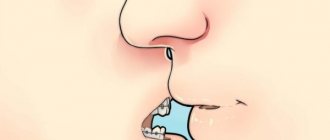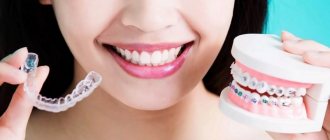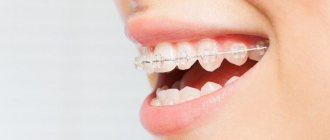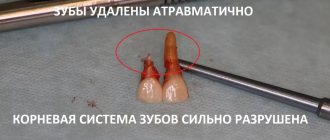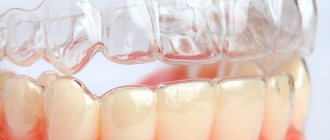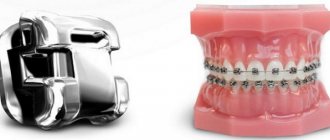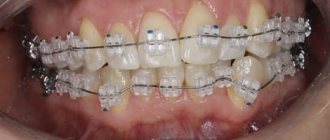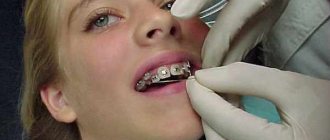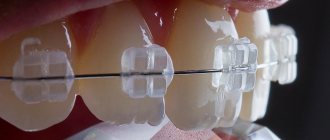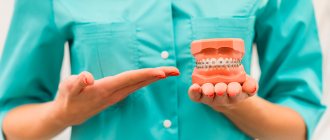Immediately after installation, braces can rub the oral mucosa and cause irritation. In most cases this is normal, you just need to be patient. If the discomfort does not go away and the symptoms intensify, you should see a doctor. In this article we will tell you what to do if your braces rub your cheeks, lips or tongue.
In this article
- When rubbing the mucous membrane with braces is the norm
- Braces rub cheeks: reasons
- What to do if braces rub your cheeks
- Wax for braces to prevent chafing
- Hygiene after installing braces
Braces are complex orthodontic structures consisting of many small parts. They are made from different materials - ceramics, plastic, sapphire or metal. Regardless of the type of system, the arc in it is always metal. It has memory and after installing braces it begins to return to the shape that was given to it during system modeling. She puts pressure on the teeth, gradually moving them in the desired direction. Due to this, the bite is slowly corrected and irregularities in the dentition are eliminated.
Braces place quite a lot of stress on the jaws. Immediately after their installation, a person feels discomfort in the oral cavity and even pain. Usually, unpleasant symptoms disappear within a few days or weeks.
People often complain that braces rub or scratch their lips and cheeks, causing small sores that bleed and hurt, especially when eating. In some cases, irritation of the tongue mucosa is observed, which can occur after the installation of lingual braces fixed on the inside of the dentition. Let's find out when such symptoms are normal and when they are not.
When rubbing the mucous membrane with braces is the norm
The oral mucosa is covered with a thin epithelial layer, penetrated by many blood vessels. Minor injuries, some products and orthodontic structures can disrupt its integrity and cause irritation. Braces are a foreign object for the body, which, when in contact with the mucous membrane, can cause a certain reaction. This happens especially often when teeth protrude strongly towards the cheeks or lips. In addition, the design itself is quite voluminous, so in some sense it increases the size of the jaw. Because of this, the contact of braces with the tissues of the oral cavity becomes more dense.
The mucous membrane recovers very quickly, without any treatment. Within a few days after installing the braces, a person ceases to feel any discomfort. If the problem does not go away, and the symptoms of damage to the mucous membrane intensify, you need to consult a doctor.
The following signs may be a reason for a visit:
- bleeding of the mucous membrane;
- pain while eating;
- the formation of ulcers and wounds covered with a white film.
If an infection gets into the wound, an inflammatory process will begin. Therefore, if you are concerned about several of the listed signs, do not try to eliminate them yourself. Most likely, the cause of these symptoms is not related to adaptation.
What are braces
Braces are a special orthodontic design designed to correct bite pathologies. Modern dentistry offers a large selection of materials for their manufacture: metal, ceramics, artificial sapphire, plastic. In this case, the arc connecting the individual staples is always metal. Braces work due to shape memory: over time, the arch takes on the shape initially given to it, as a result of which the teeth occupy the correct position.
Braces have a fairly strong impact on the jaw, so patients may feel discomfort and pain during the first time after installation of the system. They often complain that the sharp edges of the clasps or the arc itself scratches their cheeks. This can cause small ulcers that bleed and hurt when touched.
It does not matter what type of braces the orthodontist uses, even in the case of installing lingual analogues, discomfort may be observed. In this case, the structure may rub the tongue while eating or even at rest. To avoid this, professionals recommend using special wax or silicone. This is absolutely harmless, since only hypoallergenic materials are used in production.
Braces rub cheeks: reasons
There are four possible reasons why braces chafe your cheeks, lips, and tongue. Among them:
- Error when installing the arch of the orthodontic structure. The orthodontist may incorrectly trim or bend the archwire, making it too long. As a result, it begins to scratch the tissues of the oral cavity. The problem is eliminated by partially dismantling the system and reinstalling the arc.
- The lock has come unglued from the enamel. One of the main parts of the structure is the locks, which are fixed to the tooth surface using dental cement. If one of the locks has lost contact with the enamel and become detached, it will most likely rub against your cheek or lip. This rarely happens, since the fixation of the braces should be as tight as possible so that they do not move even as a result of pressure. This may lead to incorrect correction. However, the likelihood of such a complication still exists, albeit low.
- The arch of the braces jumped out of the slots of the locks. This problem also occurs rarely. The reason for its appearance is an error when installing braces or non-compliance with the rules for wearing them. Thus, a person may press too hard on the system with a toothbrush or damage it when consuming hard foods, such as carrots. If the arch from the braces jumps out of the grooves, it begins to come into contact with the mucous membrane and rub it.
- Allergy to construction material. Sores, wounds, bleeding and other symptoms may be the result of an allergic reaction. Often it occurs on some metal. In this case, it is necessary to reinstall the system, and you will have to replace it with plastic, sapphire or ceramic. You may need to give up braces in favor of aligners.
In some cases, the adaptation period is delayed, which is associated with the individual characteristics of the body, for example, increased sensitivity of the mucous membrane. To reduce the risk of developing inflammatory diseases, it is recommended to carefully observe the rules of hygiene and eat right.
What causes chafing?
Braces are a foreign structure that creates special conditions inside the oral cavity for the correction of the dentofacial apparatus. In places where soft tissues come into contact with protruding elements, increased pressure occurs on the mucous membranes. Such areas most often become the inner surfaces of the lips, cheeks and tongue.
Increased salivation, which accompanies the first stages of adaptation to braces, leads to the fact that irritation, inflammation or wounds quickly appear at the site of friction. Sometimes there may be slight bleeding.
It takes about a week for habituation and natural thickening of the integumentary tissue in the contact zone to occur. Then, in these places, the surface of the mucous membrane grows and prevents the appearance of new rubbing and irritation.
Chafing is most often associated with three things:
- chafing locks;
- the wire rubs in the area of the missing tooth;
- rubs the end of the arc.
Locks
The maximum protruding parts of the system are on the locks. They create pronounced problems on the inside of the lips. The simplest way is to provide a mechanical barrier that will increase the contact area and reduce pressure in that area. To achieve this effect, protective orthodontic wax is used.
If a ligature system is installed, you should pay attention to whether the bent ends of the metal ligatures have caused chafing. Buckling can occur after intensive cleaning with a brush. If the reason is really bending, you need to take a toothpick and place the tail under the arc. The movement must be careful not to damage the system.
Another option is for the bracket to detach from the enamel due to weakening of the dental adhesive. Then the staple hangs on the arch and strongly rubs the lip. In this case, you need to urgently go to the orthodontist, who can fix it in the desired position.
Wire in place of missing tooth
In areas where one tooth is missing, the contact of the tongue and cheek with the arch is much stronger than expected. This may be irritating at first. The solution to this picture is only possible by increasing the contact area. In such cases, doctors recommend putting a special tube on top. You cannot do this on your own; you need to contact your doctor, and he will solve this issue in a matter of minutes. Such assistance does not require material costs. In two to three weeks, adaptation should occur and the tube can be removed.
Arc ends
The wire after installation may be longer than required. If the orthodontist does not shorten or curl the ends, they can cause chafing and scraping of the soft tissue. A similar problem should be solved by the specialist who installed the structure. After shortening, the discomfort immediately goes away or decreases significantly.
What to do if braces rub your cheeks
If discomfort in the oral cavity does not go away after installing orthodontic braces, you will need the help of a specialist. Depending on the cause of the problem, he will select a method to eliminate it:
- glue the detached lock to the tooth surface, having previously removed the old glue with a solvent;
- will cut off both edges, bend and reinstall an arch that is too long;
- will put the arch in place if it has jumped out of the grooves due to the patient violating the rules of wearing braces;
- will replace the arc with a product made of a different material if the discomfort is caused by an allergy.
It is also necessary to help the patient quickly adapt to the design. To do this, he is prescribed special gels and ointments that can be used at home. If ulcers form, the doctor will select a healing or anti-inflammatory ointment to prevent the spread of infection.
Orthodontic wax
To eliminate minor difficulties, wax or, as it is also called, silicone helps.
Its purpose is to protect the oral mucosa by eliminating or minimizing chafing.
Wax is applied to areas where the bracket is protruding, causing chafing.
In most clinics, orthodontic wax is issued by a doctor immediately after installation of the structure. He gives recommendations when it is best to use this product and how it is applied.
It is important to know that chewing gum is a big no-no for a patient wearing braces. This sticky and tenacious substance can disrupt the alignment structure, and chewing gum is an excellent assistant for the growth of bacteria in the mouth.
If your doctor does not provide you with wax, you can buy it at any pharmacy. This product is sold without a doctor's prescription.
Before applying wax, it is important to determine the places where the braces rub the mucous membrane. In good lighting, use a mirror to examine the oral cavity. Having found places on the gums, lips or cheeks that are subject to rubbing, you should apply the product to the protruding parts of the structure.
Let's break down the procedure for using wax step by step:
- A small amount of wax (about the size of a match head) is cut off or turned away from the whole piece. It is better not to pull the wax to prevent it from stretching into a long ribbon that is difficult to adjust to the desired shape.
- Next, the surface on which the wax will be applied is dried. You can use cotton swabs for this, dipping the surface of the bracket and the tooth with them.
- A piece of wax is warmed in your hands, forming a ball out of it.
- Next, the ball is attached to the problem area. It is important to do this carefully so as not to disturb the structure and at the same time attach the wax well. You should also prevent wax from getting into the crevices between your teeth.
For wax to be effective, it must protrude above the surface of the structure.
All of the above manipulations are repeated step by step to eliminate chafing in all necessary places.
Before eating, it is recommended to remove wax from the surface of the structure. To do this, you can use a brush or simply remove it with your hands. Otherwise, the wax may be ingested in food. But in general it is safe for humans and there is nothing wrong with swallowing it.
If orthodontic wax is not available, beeswax or paraffin can be used.
Wax for braces to prevent chafing
If braces rub the cheek, the dentist may prescribe orthodontic wax - a special composition that is applied to the structure to protect the mucous membrane from rubbing. The composition of such products is hypoallergenic, so they are suitable for all patients. Wax is recommended to be used not only during the adaptation period, but also after tightening the braces. It should be used according to the instructions:
- Dry the part of the structure that will be waxed using cotton swabs.
- Tear off a small piece of the mixture, warm it with your fingers and roll it into a small ball.
- Attach it to the protruding part of the staples using light pressure (the wax should not be under the metal elements of the structure).
Before eating, you need to remove the wax from the braces with a brush, cotton swab or brush. But nothing bad will happen even if you swallow a little of this product. It is absolutely safe for health, including for children.
If your braces continue to scratch your cheek or lips even with wax, the system may need to be removed. The need for this will be determined by an examination.
Rules for daily hygiene care
If you have braces, you should make it a rule to take care of your teeth every day - morning, evening and after every snack. This will help maintain healthy teeth and a snow-white shade of enamel after removing braces.
- Brush your teeth with a brush and toothpaste in the morning and evening. If you have a special brush, it is necessary to carry out horizontal movements along the arch of the braces (there is a recess inside the bristles for the arch). Use a regular brush without strong pressure, using both horizontal and vertical movements. Move the head actively, clean each record separately,
- After the main cleaning, use a single-tuft brush or brushes to clean every gap between the brackets/archwires, the surface of the teeth, as well as the plates themselves, top and bottom. Pay special attention to the brackets that are located on the farthest teeth - it is on them that the largest amount of plaque accumulates, since it is with these elements that we chew food,
- Rinse your mouth with water and mouthwash for 1-2 minutes.
Cleaning can also be supplemented with an irrigator (can also be directed at the plates - the pressure should be reduced only in the presence of ceramic and sapphire systems) and dental floss.
Hygiene after installing braces
After installing braces, the requirements for oral hygiene increase, especially during the period of adaptation to the system. If you don't brush your teeth or do it poorly, germs can get into the wounds caused by rubbing. Due to the infection, treatment will be delayed. It is possible that you will have to remove the staples, treat the pathology and put them back on.
To prevent this, use special hygiene products to care for braces: brushes, dental floss, mouthwash with antibacterial properties and a special brush with V-shaped bristles.
Orthodontists also recommend cleaning your mouth 2-3 times a week with an irrigator. It is necessary to select devices with attachments designed for the care of orthodontic systems, for example, Little Doctor International Ltd Aquajet LD-A7 and Donfeel Donfeel OR-820D Compact. Before purchasing brushes and other hygiene products, consult your doctor.
Supporting measures
In the case where braces rub, every effort should be made to prevent the irritation from developing into serious inflammation, which will take a long time to heal. An infection may develop on the wounds, and then the consequences will be even more difficult to remove.
The following methods are recommended to reduce pain and chafing:
- A solution of salt and soda . In case of swelling or rubbing of braces, prepare a soda-salt solution of 1/2 tsp. soda, 1/2 tsp. salt and 250 ml warm water. You need to rinse with this solution once every 2 hours for a couple of minutes. If there are wounds on the mucous membrane, then this method should not be used, since the salt will enter the ulcer and strengthen it.
- Pharmaceutical disinfection . To accelerate the restorative properties of soft tissues and quickly eliminate chafing or wounds, dentists recommend rinsing the mouth with a furatsilin solution. It helps fight the attachment of fungi and bacteria to damaged tissue. Rinses are performed every two to three hours.
- Chamomile and calendula decoction . A decoction is made from dry inflorescences, which has a disinfecting effect. A new decoction should be prepared once a day, and rinsed once every couple of hours.
If your braces rub very hard, and you can’t get rid of the discomfort for more than two weeks, you should seek help from an orthodontist, who can find out the cause, eliminate it, or prescribe special remedies to alleviate the condition.
